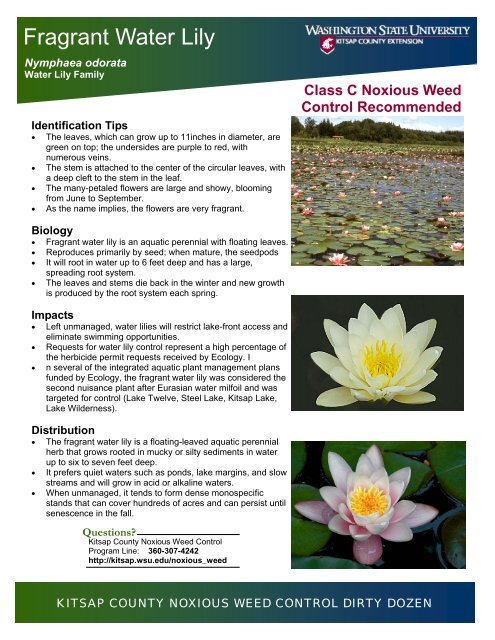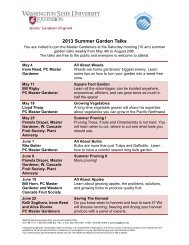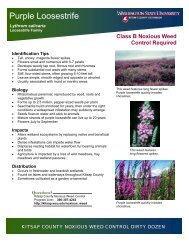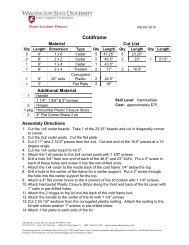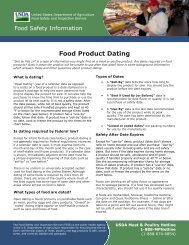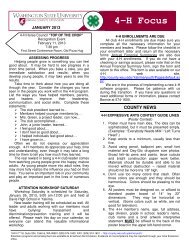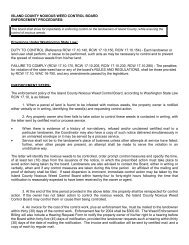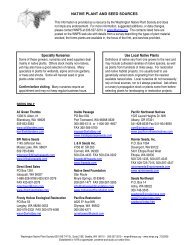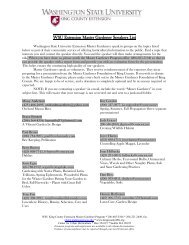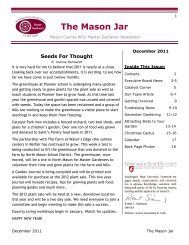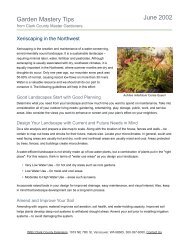Fragrant Water Lily - WSU Extension Counties - Washington State ...
Fragrant Water Lily - WSU Extension Counties - Washington State ...
Fragrant Water Lily - WSU Extension Counties - Washington State ...
You also want an ePaper? Increase the reach of your titles
YUMPU automatically turns print PDFs into web optimized ePapers that Google loves.
<strong>Fragrant</strong> <strong>Water</strong> <strong>Lily</strong><br />
Nymphaea odorata<br />
<strong>Water</strong> <strong>Lily</strong> Family<br />
Identification Tips<br />
• The leaves, which can grow up to 11inches in diameter, are<br />
green on top; the undersides are purple to red, with<br />
numerous veins.<br />
• The stem is attached to the center of the circular leaves, with<br />
a deep cleft to the stem in the leaf.<br />
• The many-petaled flowers are large and showy, blooming<br />
from June to September.<br />
• As the name implies, the flowers are very fragrant.<br />
Biology<br />
• <strong>Fragrant</strong> water lily is an aquatic perennial with floating leaves.<br />
• Reproduces primarily by seed; when mature, the seedpods<br />
• It will root in water up to 6 feet deep and has a large,<br />
spreading root system.<br />
• The leaves and stems die back in the winter and new growth<br />
is produced by the root system each spring.<br />
Impacts<br />
• Left unmanaged, water lilies will restrict lake-front access and<br />
eliminate swimming opportunities.<br />
• Requests for water lily control represent a high percentage of<br />
the herbicide permit requests received by Ecology. I<br />
• n several of the integrated aquatic plant management plans<br />
funded by Ecology, the fragrant water lily was considered the<br />
second nuisance plant after Eurasian water milfoil and was<br />
targeted for control (Lake Twelve, Steel Lake, Kitsap Lake,<br />
Lake Wilderness).<br />
Distribution<br />
• The fragrant water lily is a floating-leaved aquatic perennial<br />
herb that grows rooted in mucky or silty sediments in water<br />
up to six to seven feet deep.<br />
• It prefers quiet waters such as ponds, lake margins, and slow<br />
streams and will grow in acid or alkaline waters.<br />
• When unmanaged, it tends to form dense monospecific<br />
stands that can cover hundreds of acres and can persist until<br />
senescence in the fall.<br />
Questions?<br />
Kitsap County Noxious Weed Control<br />
Program Line: 360-307-4242<br />
http://kitsap.wsu.edu/noxious_weed<br />
Class C Noxious Weed<br />
Control Recommended<br />
KITSAP COUNTY NOXIOUS WEED CONTROL DIRTY DOZEN
Control Methods<br />
Chemical: Generally glyphosate is the recommended herbicide for water lily control because it can be<br />
directly applied to the floating leaves, unlike fluridone of endothall which must be applied to the water. The<br />
application of glyphosate allows specific plants or areas of plants to be targeted for removal. Generally two<br />
applications of glyphosate are needed. The second application controls the plants that were missed during<br />
the first herbicide application. A drawback of using herbicides, is the "uplifting" of mats of decomposing water<br />
lily roots that can form large floating islands in the waterbody after the herbicides have killed the plants.<br />
Harvesting water lilies before treating the water with a systemic herbicide such as fluridone has been shown<br />
to stress the plants and provide greater impact of the herbicide to the plants (as was demonstrated during the<br />
1991 fluridone application to Long Lake, Thurston County in <strong>Washington</strong>).<br />
Cultural: Localized control (in swimming areas and around docks) can be achieved by covering the<br />
sediment with an opaque fabric which blocks light from the plants (bottom screening). However, it is<br />
sometimes very difficult to place and secure the fabric to densely packed, tough, fleshy water lily rhizomes.<br />
Several lake residents have reported success in eliminating water lilies from waterfront lots by the process of<br />
carbohydrate depletion. During each growing season, residents faithfully removed all emerging leaves. They<br />
reported that it took about two to three seasons to kill the plants.<br />
Mechanical: Mechanical controls such as cutting and harvesting are popular methods of controlling water<br />
lilies. Cutting is less efficient than harvesting because cut plants must then be removed from the water.<br />
Harvesters both cut and collect the plants. Both methods create open areas of water. However, because<br />
water lilies grow in shallow water and grow rapidly, they must be cut several times a year.<br />
Underwater rototilling (called rotovation) was successfully used to remove water lilies from a small Seattle<br />
Lake where the drowning of two people was attributed to the presence of dense beds. Rotovation dislodges<br />
the large, fleshy water lily rhizomes which can then be removed from the water. Although rotovation is a much<br />
more expensive process than harvesting or cutting, it results in the permanent removal of water lily rhizomes.<br />
Biocontrol Potentials: General release of biocontrol agents for the fragrant water lily would not be popular<br />
because water lilies are so widely propagated for ornamental ponds. However, a number of insects, such as<br />
aphids, have been observed feeding on and impacting water lilies. The University of <strong>Washington</strong><br />
experimented with using triploid grass carp to remove fragrant and other species of water lilies from<br />
Chambers Lake, Thurston County by stocking very high rates of fish. However little or no impact of the fish on<br />
water lilies was observed in that lake. It is generally accepted that grass carp can not be effectively used for<br />
fragrant water lily management. Therefore, there are no effective biological control agents available at this<br />
time for water lily control. Nor are there likely to be any.<br />
Information Program Line: 360-307-4242<br />
Website: http://kitsap.wsu.edu/noxious_weed<br />
Cooperating agencies: <strong>Washington</strong> <strong>State</strong> University, U.S. Department of Agriculture, and Kitsap County. <strong>Extension</strong> programs and employment are<br />
available to all without discrimination. Evidence of noncompliance may be reported through your local <strong>Extension</strong> office.


